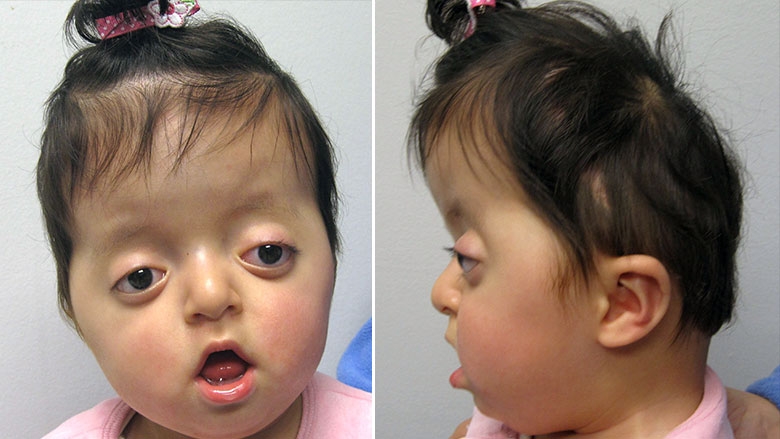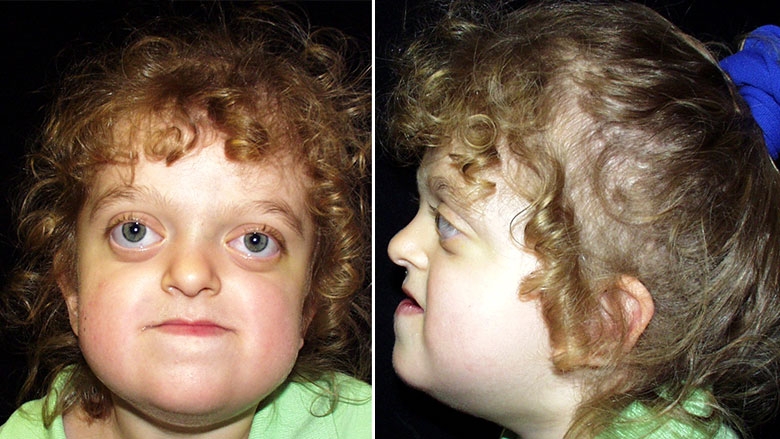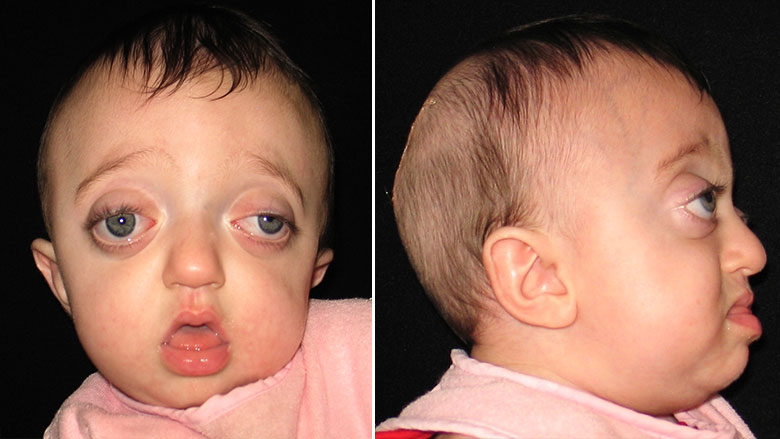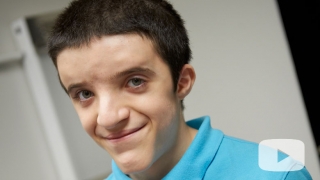Pfeiffer Syndrome
What is Pfeiffer syndrome?
Pfeiffer syndrome, also known as acrocephalosyndactyly Type V, is a genetic disorder characterized by the anomalies of the skull, face and limbs. Gene mutations are responsible for causing the early fusion of the skull, hand and feet bones. Craniofacial differences are similar to those seen in Apert syndrome.
Individuals with Pfieffer syndrome typically have the following conditions:
- Craniosynostosis: early closure of one or more of the seams between the skull bones, causing an abnormal skull. This results in a skull shape with increased vertical height. Typically, both coronal sutures (the seams that run from ear to ear over top of the head and meet at the soft spot in the middle) are fused, causing a very tall forehead and wide, short skull. Additionally, there can be fusion of the sagittal suture (the seam that runs from the front to the back of the skull).
- Midface hypoplasia: decreased growth of the midface. This causes a crescent moon or sunken facial appearance with depressed nasal bridge and beak nose. Decreased growth of the central face can contribute to obstructive sleep apnea and airway concerns.
- Syndactyly: occasional partial fusion of the second and third fingers.
- Broad thumb and great toe: differences of these digits are the hallmark of the syndrome
- Tracheal anomalies: tracheal cartilages may be fused into a long tube of solid cartilage or the trachea may be narrowed
Other common characteristics include large, elongated forehead, shallow eye sockets causing prominent eyes, narrow palate with or without a cleft, beak-like nose, and hearing loss. The characteristic feature that distinguishes Pfieffer syndrome from other types of syndromic craniosynostosis is the presence of the broad thumb and great toe.
There are three types of Pfeiffer syndrome, each with varying degrees of severity. Children with type 2 and 3 typically have nervous system issues; children with type 2 may also present with a cloverleaf-shaped head. Appearance can vary depending on if your child is mildly or more severely affected.
Pfeiffer syndrome complications and treatment
Patients with Pfeiffer syndrome can have related health and developmental issues, reinforcing the need for coordinated, multidisciplinary care and access to a variety of pediatric subspecialists.
At Children's Hospital of Philadelphia, we have a comprehensive Craniofacial Program where patients are seen by the following specialties:
- Plastic surgeons: craniofacial and hand surgeons
- Oral surgeons
- Neurosurgeons
- Otolaryngologists (ear, nose and throat specialists)
- Pediatric dentists
- Craniofacial-trained orthodontists
- Geneticists
- Speech and language pathologist
- Audiologist
- Psychologists
- Advanced Practice Providers – NPs and PAs
- Nurses
- Pulmonary Medicine
The treatment of Pfeiffer syndrome is dependent upon both functional and appearance-related needs, and should be addressed immediately after your child is born. Because of the complex issues that can be associated with Pfeiffer syndrome, your child should be treated at a medical center where she will have access to pediatric specialists across the many clinical areas she may need.
At CHOP, coordinated care of patients with Pfeiffer syndrome is typically managed through the Craniofacial Program, working closely with the Hand and Arm Disorders Program to treat congenital deformities of the hand; the Center for Pediatric Airway Disorders to address breathing issues; and the Pediatric Feeding and Swallowing Center to manage feeding issues. Eye protection or balance issues, such as strabismus, are coordinated through the Division of Ophthalmology.
Because every patient with Pfeiffer syndrome has unique problems, the timing and course of surgical treatment is highly individualized. It is important to see a surgeon with expertise in pediatric plastic, reconstructive and oral surgery who specializes in treating this rare condition. Learn more about the surgical treatment approach for syndromic craniosynostosis.
As your child grows, CHOP also provides access to psychosocial support services to address any mental, social or psychological issues that accompany these conditions.
Watch our educational video to learn more about the services and treatment options CHOP offers to children with craniofacial conditions such as Pfeiffer syndrome.
Reviewed by Scott P. Bartlett, MD, Jesse A. Taylor, MD




